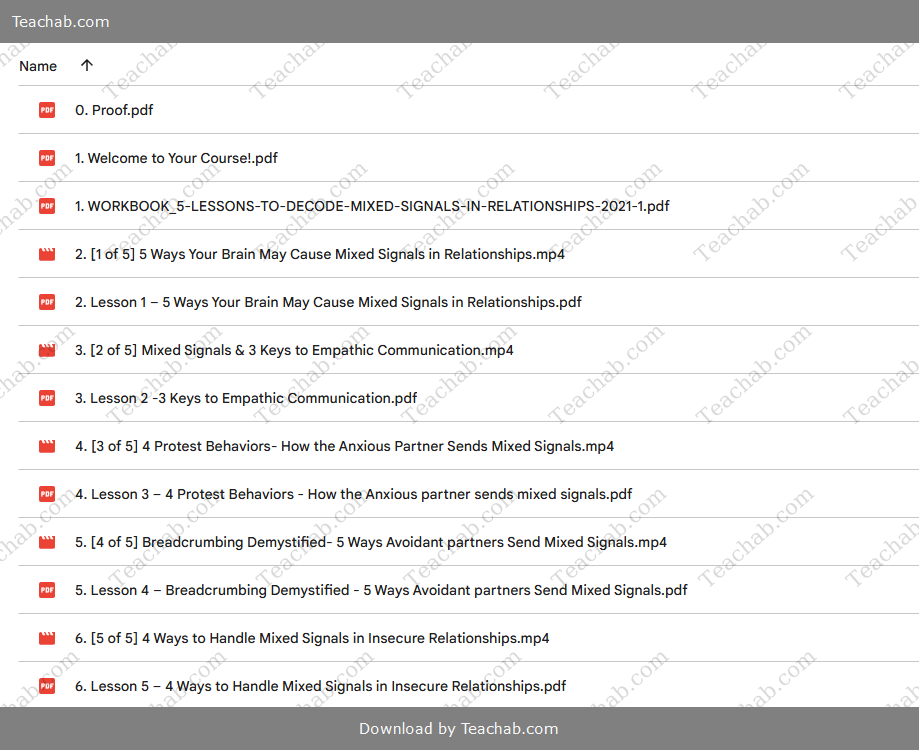5 Lessons to Decode Mixed Signals in Relationships By Briana MacWilliam
$167.00 Original price was: $167.00.$30.80Current price is: $30.80.
5 Lessons to Decode Mixed Signals in Relationships – Immediate Download!
Content Proof:

In the intricate web of romantic connections, communication functions as both the thread and the needle, binding together shared experiences and emotions between two individuals. However, one of the greatest challenges people encounter is interpreting the mixed messages that can unravel these bonds, leading to uncertainty and emotional distress. In her insightful work, Decoding Mixed Signals in Relationships, Briana MacWilliam presents a structured framework that clarifies the complexities of partner interactions. Through five key lessons, she navigates readers through the maze of emotional cues, emphasizing awareness, dialogue, and mutual comprehension. Let’s explore these principles and how they can empower individuals to build stronger, more fulfilling relationships.
Understanding Attachment Styles
A fundamental aspect of MacWilliam’s approach revolves around the impact of attachment styles. These underlying patterns dictate how individuals connect with others and express emotions. Gaining clarity on one’s own attachment tendencies, as well as those of a partner, is crucial. Attachment styles generally fall into four categories: secure, anxious, avoidant, and disorganized.
- Secure attachment fosters openness, emotional honesty, and a balanced approach to closeness.
- Anxious attachment leads individuals to crave intimacy yet fear abandonment, often resulting in overanalyzing a partner’s actions.
- Avoidant attachment compels individuals to maintain emotional distance, resisting dependence and vulnerability.
- Disorganized attachment is marked by inconsistent behavior, typically stemming from past trauma.
Recognizing these tendencies can significantly influence how partners communicate and interpret each other’s actions. For instance, a person with an anxious attachment style may misinterpret an avoidant partner’s need for space as indifference, whereas the avoidant partner may feel overwhelmed by their partner’s desire for closeness. By identifying these patterns, couples can navigate emotional interactions more effectively and foster a more secure foundation in their relationship.

Recognizing Mixed Signals
One of MacWilliam’s essential teachings involves the ability to identify mixed messages. These signals often appear in different forms, leaving one partner feeling emotionally unsteady. A classic example is the “disappearing act,” where someone oscillates between intense engagement and sudden withdrawal, leaving their partner uncertain about their true intentions.
Types of Mixed Signals
| Type | Description |
|---|---|
| Disappearing Act | Alternating between intense attention and silence. |
| Love Bombing | Overwhelming affection followed by emotional detachment. |
| Inconsistent Presence | Fluctuating between accessibility and unavailability. |
| Ambiguous Messaging | Conflicting verbal and non-verbal cues that create confusion. |
Understanding these patterns allows individuals to navigate their emotions more effectively. Awareness of mixed signals is the first step toward addressing relationship confusion, enabling constructive discussions instead of feelings of self-doubt or frustration. Recognizing that these behaviors are common in many relationships can also provide reassurance to those struggling with uncertainty.
Effective Communication Strategies
MacWilliam underscores the importance of clear communication as a means of overcoming confusion. The way one expresses their thoughts and feelings can serve as a guiding light in the stormy seas of emotional uncertainty. She advocates for open and sincere discussions, which pave the way for a healthier exchange of perspectives and emotions.
A key technique she recommends is the use of “I” statements, which help individuals convey their feelings without blaming their partner. This approach fosters a more non-defensive and constructive dialogue. For example, rather than saying, “You never pay attention to me,” one could express, “I feel unimportant when I don’t receive your attention.” This subtle shift in phrasing can significantly reduce conflict and promote understanding.
MacWilliam also suggests several communication principles to enhance conversations:
- Be transparent – Express emotions openly without fear of rejection.
- Practice active listening – Show genuine interest by paraphrasing and validating your partner’s words.
- Stay on topic – Avoid bringing up unrelated past issues that can derail the conversation.
- Check in regularly – Set aside time to discuss feelings and relationship dynamics before tensions escalate.
By integrating these strategies, couples can minimize misinterpretations and cultivate a relationship built on clarity and trust.
Self-Reflection
Another crucial element MacWilliam highlights is the power of self-reflection. Understanding one’s own emotions, biases, and reactions is essential when navigating mixed signals. This process can be compared to looking in a mirror—while the reflection may sometimes be uncomfortable, self-awareness is key to personal growth and relational clarity.
Individuals are encouraged to explore how past experiences and personal insecurities shape their perceptions of mixed messages. For example, someone who has experienced past betrayal might interpret neutral behaviors as signs of dishonesty, while a securely attached individual may take those same behaviors at face value.
Steps for Self-Reflection
- Journaling – Write about interactions where mixed signals appeared and analyze your emotional reactions.
- Mindfulness Practices – Use meditation or deep breathing exercises to explore feelings with greater clarity.
- Therapeutic Support – Seek guidance from a professional to gain deeper insights into emotional patterns.
- Peer Feedback – Consult trusted friends or mentors for an outside perspective on relational concerns.
Through self-reflection, individuals can gain deeper emotional intelligence, allowing them to respond to relationship challenges with greater intention and awareness.
Seeking Mutual Understanding
Finally, MacWilliam highlights the necessity of seeking mutual understanding to cultivate stronger emotional bonds. This process requires active effort from both partners to engage in meaningful discussions and explore each other’s perspectives with curiosity rather than defensiveness.
Practices for Building Mutual Understanding
- Regular Emotional Check-Ins – Dedicate time for open conversations about feelings, needs, and relationship dynamics.
- Empathy Exercises – Practice taking turns sharing emotions while the other partner listens attentively.
- Shared Activities – Engage in collaborative activities that encourage teamwork and deeper connection.
- Reflective Questions – Ask insightful questions such as, “How do you truly feel about this situation?” to encourage open dialogue.
By fostering a relationship culture rooted in empathy and genuine connection, couples can better navigate mixed signals and create a foundation of emotional security.
Conclusion
Briana MacWilliam’s approach to decoding mixed signals offers valuable tools for those navigating the complexities of romantic relationships. By understanding attachment styles, recognizing mixed signals, implementing effective communication techniques, engaging in self-reflection, and fostering mutual understanding, individuals can establish healthier and more rewarding connections. These five core lessons provide a structured pathway to greater emotional clarity, deeper intimacy, and reduced misunderstandings. As these strategies become part of a couple’s dynamic, they can strengthen their bond, enhancing trust, compassion, and long-term relational fulfillment.
Frequently Asked Questions:
Business Model Innovation: We operate a group buying strategy, allowing participants to share costs and access popular courses at reduced prices. This model benefits individuals with limited financial resources, despite concerns from content creators about distribution methods.
Legal Considerations: The legality of our operations involves complex issues. Although we don’t have explicit permission from course creators to resell their content, there are no specific resale restrictions stated at the time of purchase. This ambiguity creates an opportunity for us to provide affordable educational resources.
Quality Control: We ensure that all course materials purchased are identical to those offered directly by the creators. However, it’s important to understand that we are not official providers. As such, our offerings do not include:
– Live coaching calls or sessions with the course author.
– Access to exclusive author-controlled groups or portals.
– Membership in private forums.
– Direct email support from the author or their team.
We aim to reduce the cost barrier in education by offering these courses independently, without the premium services available through official channels. We appreciate your understanding of our unique approach.
Be the first to review “5 Lessons to Decode Mixed Signals in Relationships By Briana MacWilliam” Cancel reply
You must be logged in to post a review.

















Reviews
There are no reviews yet.